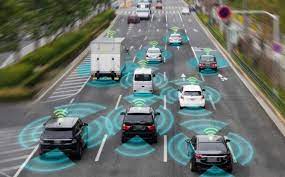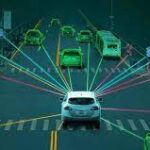
AI in Transportation
AI’s Impact on Transportation:
The transportation industry has undergone tremendous changes in the last few decades thanks to technological advancements. Self-driving cars and intelligent traffic management are some of the most significant innovations that have transformed how people move from one place to another. Artificial intelligence (AI) has been at the forefront of these changes, bringing a new level of sophistication to the transportation industry. Today, AI-powered systems are being used to improve transportation safety, efficiency, and sustainability.
This article will explore the impact of AI on transportation, from self-driving cars to intelligent traffic management. It will also look at AI-powered transportation systems’ benefits, challenges, and the future of this exciting field. So, buckle up and get ready to ride into the world of AI and transportation!
Self-Driving Cars and Their Impact on Transportation:

AI in Transportation
Self-driving cars, also known as autonomous vehicles, are cars that can navigate and make decisions on their own without human input. They use a combination of sensors, cameras, and software to sense their surroundings and make decisions based on that information. Self-driving cars have the potential to revolutionize the transportation industry in several ways.
Benefits of Self-Driving Cars:
One of the most significant benefits of self-driving cars is increased safety. According to the National Highway Traffic Safety Administration (NHTSA), 94% of car accidents in the US are caused by human error. Self-driving cars can eliminate this risk by removing human error from the equation. They can detect and respond to hazards much faster than humans and can make decisions based on data and algorithms. This can significantly reduce the number of accidents on the road and save countless lives.
Another benefit of self-driving cars is increased efficiency. The average American spends an average of 54 hours a year in traffic, which translates to billions of dollars in lost productivity. Self-driving cars can help alleviate traffic by optimizing routes and reducing congestion. They can communicate with each other and adjust their speed and direction to avoid collisions and maintain a steady traffic flow. This can save drivers time and money and reduce transportation’s environmental impact.
Self-driving cars can also increase mobility for people who cannot drive, such as the elderly, disabled, or visually impaired. They can provide a safe and reliable mode of transportation for those who cannot operate a vehicle themselves. This can improve millions of people’s access to healthcare, employment, and social activities.
Challenges and Limitations of Self-Driving Cars:
While self-driving cars have the potential to revolutionize transportation, several challenges and limitations must be addressed before they become mainstream.
One of the biggest challenges is the technology itself. Self-driving cars are still in the early stages of development, and many technical hurdles must be overcome. For example, self-driving vehicles must be able to navigate complex and unpredictable environments, such as construction zones, bad weather, and unexpected road closures. They must also be able to communicate with other vehicles and infrastructure in real-time to avoid collisions and maintain traffic flow.
Another challenge is public acceptance. Many people are skeptical of self-driving cars and may be hesitant to trust them with their safety. There is also the question of liability – who is responsible in the event of an accident? These complex legal and ethical questions must be addressed before self-driving cars become mainstream.
Smart Traffic Management Systems Powered by AI:
Smart traffic management systems use AI-powered algorithms to optimize traffic flow and reduce congestion. They use sensors and cameras to collect real-time data on traffic patterns, weather conditions, and other factors that affect traffic. This data is then analyzed to make real-time traffic flow and signal timing decisions.
Benefits of Smart Traffic Management Systems:
The benefits of smart traffic management systems are similar to those of self-driving cars – increased safety, efficiency, and sustainability. By optimizing traffic flow and reducing congestion, smart traffic management systems can reduce the likelihood of accidents and save time for drivers. They can also reduce emissions by minimizing idle time and stop-and-go traffic.
Smart traffic management systems can also improve emergency response times by prioritizing emergency vehicles and rerouting traffic in real time. This can save lives in the event of an emergency and reduce the impact of accidents on traffic flow.
Challenges and Limitations of Smart Traffic Management Systems:
One of the biggest challenges of intelligent traffic management systems is the cost. These systems require significant investment in infrastructure, sensors, and software. It may take years or even decades for these systems to become widespread.
Another challenge is data privacy. Smart traffic management systems collect large amounts of data from cameras and sensors, raising concerns about privacy and surveillance. Regulations must be put in place to protect the privacy of individuals while still allowing for the collection and use of traffic data.
AI-Powered Predictive Maintenance in Transportation:
AI-powered predictive maintenance uses machine learning algorithms to predict when maintenance will be required on vehicles and infrastructure. By analyzing data on usage, wear and tear, and other factors, these algorithms can identify potential problems before they occur. This can help prevent breakdowns and reduce maintenance costs.
Impact of AI on Public Transportation:
AI is also having a significant impact on public transportation. Many cities use AI-powered systems to optimize bus routes, predict demand, and reduce passenger wait times. These systems can also improve accessibility for riders by providing real-time information on routes, schedules, and delays.
Another area where AI is impacting is the development of electric and autonomous buses. These buses can reduce emissions and improve safety, making public transportation more sustainable and attractive for commuters.
Ethical and Social Implications of AI in Transportation:
As with any new technology, AI in transportation raises ethical and social implications that must be addressed. For example, self-driving cars raise questions about the role of humans in transportation and the potential displacement of jobs in the transportation industry. There are also concerns about data privacy, cybersecurity, and the impact of AI on marginalized communities.
Conclusion:
AI is transforming the transportation industry in ways that would have been unimaginable just a few decades ago. From self-driving cars to smart traffic management systems, AI is improving transportation safety, efficiency, and sustainability. While challenges and limitations remain to be addressed, the future of AI in transportation is bright. As we continue to develop and refine these technologies, we have the opportunity to create a transportation system that is safer, more efficient, and more accessible for everyone.

Pingback: Future of AI Technology
Pingback: Dangers of Artificial Intelligence